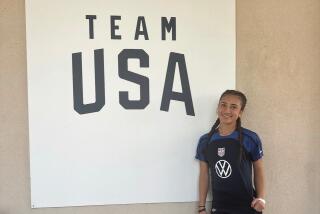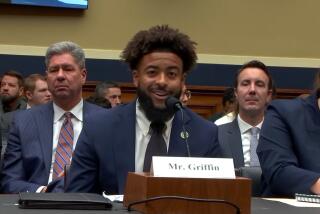Some Athletes Bemoan Lack of Support
Andre Hayes is a business success. He owns a thriving car-detail operation in downtown Los Angeles, and says he will earn enough within a year to pay off two-year-old student loans.
Hayes also is a success in the classroom.
He flunked out of the University of Washington for a quarter but went back and earned a bachelor’s degree in criminal justice. He passed the Law Scholastic Aptitude Test last year and plans to enroll in law school.
Hayes is one former Washington football player Coach Don James could point to as a model student-athlete.
If only he would cooperate.
But with academics one of the National Collegiate Athletic Assn.’s most pressing issues after decades of seemingly little concern, Hayes is not about to let educators--or coaches--off the hook.
Even with politicians and college presidents discussing ways to improve graduation rates and grade-point averages--particularly in football and men’s basketball--Hayes is skeptical.
“I didn’t feel like a student until I got done playing,” said Hayes, who graduated in 1987. “Then I got to see what it was really like, just going to school.”
Hayes said that despite recent talk of increasing graduation rates, the system leaves something to be desired. He said that as much as 80% of his time as a player was monopolized by practice, football meetings and watching game films. Hayes, 26, and other former players who attended major football schools in the 1980s, offered insight into why athletes do not graduate.
“You get some who have the wrong attitude about why they are there,” said Hayes, who attended St. Bernard High in Playa del Rey. “They forget they are also students. Although a small percentage make the NFL, this is their main objective.”
Hayes has returned to Los Angeles high schools to advise promising athletes. He says most youngsters are surprised to hear about low graduation rates and the even lower number of those who become pros.
Recruiters do not emphasize those points when trying to persuade an athlete to attend their school, Hayes said, adding, “I tell these kids, ‘You’ve got to find out on your own before it’s too late.’ ”
For football players Martin French of USC and Jamelle Holieway of Oklahoma, the realization hit after season-ending injuries that probably also ruined their chances of playing professionally.
French, who went to Fairfax High, was a defensive back when he broke an ankle in the 1985 Rose Bowl game against Ohio State. He wore a cast for six months and had three ankle operations.
“That made me restructure my thinking, as far as I’ve got to have something to back myself up,” said French, today the weekend sports producer for KTTV.
“It never really hit until I was out and realized I might not play anymore, and I had to get something else going. A lot of people are not fortunate enough to get hurt like I did.”
Holieway, who as an 18-year-old freshman quarterback in 1985 led the Sooners to a national championship, also was struck with the realization after suffering a knee injury late in his junior season.
“It was a concern of mine to graduate,” said the 1984 City Section player of the year at Wilmington Banning. “Especially after I was injured, lying in the hospital, I had a lot of time to think about it and to reconsider my options. I thought I was going to play pro ball.”
French, a communications major, and Holieway, who studied criminal justice, have yet to fulfill their academic requirements to earn their degrees, but they are close.
French returned to USC last fall to complete one class as part of the Degree Assistance Program instituted four years ago. Seventy-six athletes have enrolled in the program, and 46 have graduated, said Mike McGee, USC’s athletic director.
Holieway said he needs to take one test in a criminal law class to finish.
“I told my mother that degree is her Christmas present,” he said.
Holieway, who played for a program now serving a three-year probation for recruiting violations, came close to graduating within four years.
He said his mother’s encouragement kept him going to classes, and earning credits at local community colleges during the summer. Although Oklahoma’s football team has a less-than-envious academic record, Holieway has no regrets.
“They did what they had to do; I did what I had to do,” said Holieway, who recruits athletes for a Costa Mesa sports agent and is training to try out with an NFL team next year.
“They gave me an opportunity to get my degree and I’m doing that. They got their four years of football out of me. That’s what a scholarship is. They give you free education, you give them athletics, and after that they can’t ask no more or no less.”
Hayes disagrees. He maintains that educators are shirking their responsibility when dealing with certain athletes, particularly those from the inner city.
“The (Washington) athletic department pushed players to take certain courses where there were friendly professors, but also to majors where the requirements weren’t as strict,” Hayes said.
He recalled one prominent Husky, whom he would not name, who could not complete an application to rent a house when they were roommates.
“I was wondering how this guy was getting through his classes,” Hayes said. “No one ever sat down and talked to him: ‘You need to do this or need to do that.’ We needed more counseling . . . not just throwing him some classes just so he could be eligible for the following season.”
Hayes said that Washington had professors who would allow academically ineligible football players to take correspondence courses as extra credit. Most schools offer correspondence courses.
“You should see some of the papers these guys wrote and (what the professors) let them get away with,” he said.
Washington’s overall graduation rate submitted to the NCAA last year was 48.2%. according to Tim Washburn, the director of admissions and records. For scholarship athletes in all sports it was 42.9%.
Gertrude Peoples, director of student services for Washington athletes, said players were neither encouraged to take certain courses nor does the university have professors sympathetic to athletes’ eligibility.
She discourages athletes from taking correspondence courses because such courses are usually more difficult.
“Courses don’t crop out of the air where kids can do minimal work and get a grade,” Peoples said. “There just aren’t any. I’d rather have someone ineligible than to have them take a class like that.”
In an effort to cater to each athlete’s needs, however, she said her counselors help athletes shape their academic future.
“Every major is not realistic for everybody,” Peoples said. “Not everyone can be a physics major. After two years, if a business major didn’t work out, we would help them find something better suited to them.”
That happened to Hayes, who spent two years studying business but was unable to advance in the difficult school with a 2.7 GPA. He switched to the study of white-collar crime.
Said Peoples: “In my tenure (18 years), coaches at Washington have encouraged kids to graduate. We’ve set up good tutorial programs. . . . I don’t know what anyone else could do.
“It makes me sad if someone left thinking they got shortchanged. It is not a program that tries to take away from kids and give nothing back.”
Although administrators cite statistics purporting to show that many of the problems are being rectified, Hayes is doubtful. All he has to do is cite schools such as Oklahoma and North Carolina State, which still have abysmal graduation records and GPAs.
“I don’t blame them so much for trying to lie or distort the truth,” Hayes said of administrators. “I think, quite honestly, a lot of them believe they are doing the right thing. A lot of them believe that their system is working.”
He also had only praise for Peoples’ work with Washington athletes.
But in 1987, when Hayes earned his degree two years after his eligibility had ended, he said only three Husky football players were in the graduating ceremonies.
“It was pretty ridiculous,” he said. “This is what it has been reduced to? It actually boils down to being a meat market--they get what they can out of you and they ship you out.
“These administrators need to come down to the corner of South Central L.A. and see the background where they are getting these kids and realize if (the athletes) don’t make it, look what they have to come back to. It’s a one-shot deal for these kids. They have to succeed or they have to go back and deal with it.”
Peoples said coaches and professors understand cultural problems attached to recruiting inner-city players.
She said living in Seattle is an advantage to such athletes because they are given a chance to see another side of life. She said 70% of the scholarship athletes stay in Washington after finishing school.
Furthermore, she said, several former Husky football players have returned to earn their degrees six years after the fact. Each is given one year’s free education.
Reggie Rogers enrolled for the winter quarter, which started on Wednesday. But he must await a Jan. 16 sentencing date for a conviction of negligent homicide in the deaths of three teen-agers stemming from a drunken-driving accident last year in Detroit.
In 1986, his older brother Don, also a football star, died of a drug overdose.
Reggie Rogers said returning to school offers a glimmer of hope after these tragedies. He is 33 units shy of earning a degree in psychology, and hopes to finish in two quarters.
“I was hoping to play a substantial amount in the NFL to save up a lot of money because the field (child psychology) I wanted to go in to doesn’t make a lot of money,” he said.
But injuries from the accident made it difficult to play professionally with the Detroit Lions and he was cut. So he returned to school sooner than expected.
Unlike Hayes, Rogers said that Washington took care of athletes’ academic needs. He said a mandatory study hall after football practices forced the players to do their homework.
“If they didn’t make me do that, I would have gone right home and gone to bed,” he said.
Rogers tried to play football and basketball, but dropped basketball his junior season because of the rigors of being a student-athlete. He said he almost flunked out because of the two-sport demands.
“It’s really hard going to class when you’re an athlete,” he said. “My energies were elsewhere. But basketball was too much. We would leave on a trip on Wednesday and return on Sunday. Some of the professors wouldn’t let you make up the tests.”
Whenever he starts, Rogers will have a friend in class. Another former Washington player, tight end Rod Jones of the Seattle Seahawks, also returned last week.
Jones said he is one or two years away from earning a degree in society and justice. What did he do during the five years he played football?
“School and sports is very difficult,” he said. “I even went to summer school every summer. I don’t think it matters when you graduate as long as you do it.”
Even Hayes would agree with that.
More to Read
Go beyond the scoreboard
Get the latest on L.A.'s teams in the daily Sports Report newsletter.
You may occasionally receive promotional content from the Los Angeles Times.










